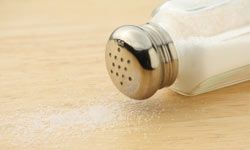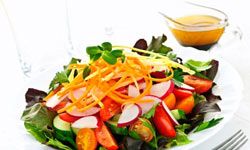 “Most Americans consume more than twice the amount of salt they should. See more salt pictures.©iStockphoto.com/DanielTaeger
“Most Americans consume more than twice the amount of salt they should. See more salt pictures.©iStockphoto.com/DanielTaeger
In "Margaritaville," Jimmy Buffet sang about his lost shaker of salt, and health experts believe many people have a similar love affair with putting the white stuff on everything from cocktails to desserts. Since our bodies do need some sodium in order to function properly, the American Heart Association (AHA) recommends about 1,500 milligrams (a little more than a half-teaspoon) a day. But most Americans consume more than double that amount through pre-packaged food, restaurant meals, and a dependency on the salt shaker. A low-sodium diet has many potential health benefits, including lowering blood pressure, which reduces your risk of heart attack and stroke. But, if you’re someone who’s used to having that extra shake or two from the salt shaker, it could be tough to kick the habit — especially at dinnertime. Here are five tips to make the process a little easier.
Contents
- Experiment with Flavor
- Say Goodbye to the Salt Shaker
- Don't Invite Salt to Dine Out
- Learn the Labels
- Avoid Convenience Foods
5. Experiment with Flavor
Professional chefs often experiment with a variety of ingredients to amp up the flavor in dishes, and you can do the same as you lower your sodium intake. There are a wide variety of spices from all over the world you can introduce to your palate, and with so many new flavors, your taste buds might not even notice the absence of salt. For example, acids like lemon juice or vinegar can brighten the flavor of your food when used sparingly. Another trick is to taste the food you cook for dinner before you salt it. You might be surprised how good a recipe tastes without it, but if it really seems to be lacking, try an alternate ingredient before grabbing the salt or salt substitute.
Common Salt Alternatives
- Celery Seed
- Cinnamon
- Cumin
- Fresh Herbs
- Garlic
- Lemon Juice
- Nutmeg
- Oregano
- Tarragon
- Vinegar
4. Say Goodbye to the Salt Shaker
 “Break up with your saltshaker — leave it in the cupboard.©iStockphoto.com/Thinglass
“Break up with your saltshaker — leave it in the cupboard.©iStockphoto.com/Thinglass
If you’re used to sprinkling salt on your supper, it might be time to remove temptation altogether. According to the AHA, adding salt at the table doesn’t really have much of a positive effect on your meal, since salt enhances the flavors of a dish best while it’s cooking. Take the salt off the table and hide it in a cabinet with the rest of your spices. If you can’t quit cold turkey, ask your doctor if you can use a salt substitute. These low-sodium blends will add some zest to your food without upping your salt intake. If your salt shaker is like a best friend, try tricking your mind by dumping out the salt and add a substitute to the container. That way, you still have the familiar shaker, but skip the salt.
3. Don't Invite Salt to Dine Out
 “Ask for salad dressing and sauces on the side.©iStockphoto.com/Elenathewise
“Ask for salad dressing and sauces on the side.©iStockphoto.com/Elenathewise
Going out for dinner might be the most challenging aspect of a low-sodium diet, but there’s no reason you can’t enjoy a night out with a few modifications. Before you go, look at the restaurant’s Web site to see if nutritional information is available. If it’s not, don’t be afraid to ask questions when you arrive. Can they cook an item without salt? Is the baked potato rolled in salt? These are good examples of questions to ask that will help you make an informed decision. Additionally, avoid fried foods, which usually contain an absurd amount of sodium, and ask for items like sauces or dressings on the side, so you can control how much of these typically sodium-filled items you eat. Finally, ask for substitutions. For example, if a meal comes with French fries, ask for a side salad instead. With a little preparation, you can have a great restaurant meal without the salty dinner companion.
2. Learn the Labels
Eating low-sodium meals at home starts at the grocery store, and reading nutrition labels will help you make the right choices when you’re there. The most common keywords to look for are "soda" or "sodium." Remember that ingredients appear in order of most to least, so if sodium appears in the first five ingredients, you can count on that product containing a pretty heavy dose. Many convenience foods have low-sodium versions, but it’s always a good idea to check out how many milligrams are in the low-sodium product, because it might not be as low as you’d like. In addition, learn what different terms mean. For example, there’s a difference between "no salt" and "no salt added." If a product says "no salt added," that doesn’t mean it’s salt-free, it just means the food manufacturer didn’t add more to it.
Sodium Ingredients to Avoid
- Baking powder
- Baking soda
- Disodium phosphate
- Monosodium glutamate (MSG)
- Sodium alginate
- Sodium nitrate
1. Avoid Convenience Foods
Canned and pre-packaged foods like soups and frozen dinners are called convenient for a reason. Simply zap them in the microwave, and you have entire meals that are ready to eat in a matter of minutes. But these foods typically contain a bunch of unhealthy ingredients, like sodium, that are meant to preserve the meals for a long time. The AHA says up to 75 percent of our sodium consumption comes from these types of food, so eliminating convenience foods may be the best way to excel at a low-sodium diet. Instead of eating canned soups or TV dinners, control how much salt is in your meals by making your own to freeze for later. You might spend more time preparing these foods, but the convenience will come into play later, when you have a freezer full of low-sodium, homemade goodies to choose from. Like the other strategies on this list, avoiding convenience foods at dinner just makes it easier to become a low-sodium diet success.
Common High-sodium Foods
- Canned soup
- Frozen meals
- Lunch meat
- Olives and pickles
- Potato chips
- Salad dressing and marinades
- Tomato sauce
Lots More Information
Related Articles
- 5 Sodium-free Foods for Dinner
- How Salt Works
- 5 Sodium Myths Debunked
Sources
- American Heart Association. "Shaking the Salt Habit." July 26, 2010. (Oct. 26, 2010)http://www.heart.org/HEARTORG/Conditions/HighBloodPressure/PreventionTreatmentofHighBloodPressure/Shaking-the-Salt-Habit_UCM_303241_Article.jsp
- Mayo Clinic. "Sodium: How to tame your salt habit now." (Oct. 26, 2010)http://www.mayoclinic.com/health/sodium/NU00284
- Ozersky, Josh. "Chefs Love Salt — Too Much and Not Well." TIME Magazine. May 17, 2010. (Oct. 27, 2010)http://www.time.com/time/magazine/article/0,9171,1987591,00.html
- Zelman, Kathleen. "Low-Sodium Diet: How to Eat Less Sodium at Restaurants." WebMD. (Oct. 26, 2010)http://www.webmd.com/diet/low-sodium-diet-restaurants































